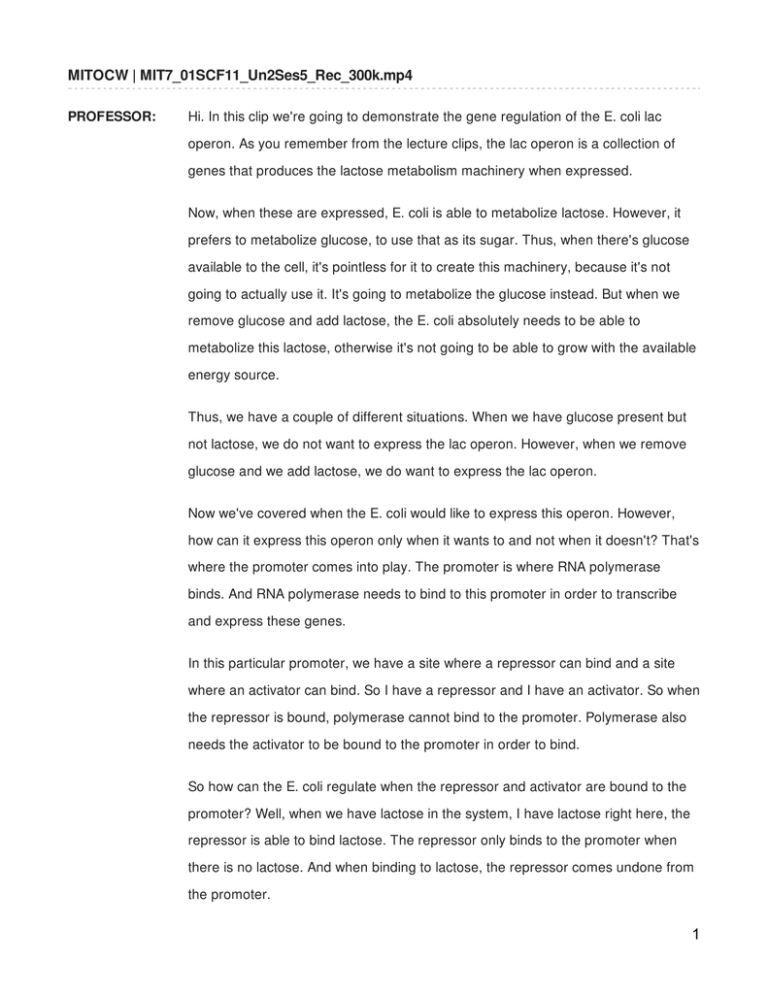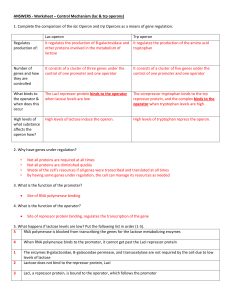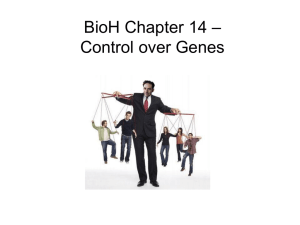MITOCW | MIT7_01SCF11_Un2Ses5_Rec_300k.mp4
advertisement

MITOCW | MIT7_01SCF11_Un2Ses5_Rec_300k.mp4 PROFESSOR: Hi. In this clip we're going to demonstrate the gene regulation of the E. coli lac operon. As you remember from the lecture clips, the lac operon is a collection of genes that produces the lactose metabolism machinery when expressed. Now, when these are expressed, E. coli is able to metabolize lactose. However, it prefers to metabolize glucose, to use that as its sugar. Thus, when there's glucose available to the cell, it's pointless for it to create this machinery, because it's not going to actually use it. It's going to metabolize the glucose instead. But when we remove glucose and add lactose, the E. coli absolutely needs to be able to metabolize this lactose, otherwise it's not going to be able to grow with the available energy source. Thus, we have a couple of different situations. When we have glucose present but not lactose, we do not want to express the lac operon. However, when we remove glucose and we add lactose, we do want to express the lac operon. Now we've covered when the E. coli would like to express this operon. However, how can it express this operon only when it wants to and not when it doesn't? That's where the promoter comes into play. The promoter is where RNA polymerase binds. And RNA polymerase needs to bind to this promoter in order to transcribe and express these genes. In this particular promoter, we have a site where a repressor can bind and a site where an activator can bind. So I have a repressor and I have an activator. So when the repressor is bound, polymerase cannot bind to the promoter. Polymerase also needs the activator to be bound to the promoter in order to bind. So how can the E. coli regulate when the repressor and activator are bound to the promoter? Well, when we have lactose in the system, I have lactose right here, the repressor is able to bind lactose. The repressor only binds to the promoter when there is no lactose. And when binding to lactose, the repressor comes undone from the promoter. 1 How does the cell tell whether there's glucose in the cell or not? When glucose is low in the cell, the cell makes a molecule called cyclic AMP, or CAMP. I have a molecule of CAMP right here. And so CAMP is the cell's way of indicating that there is low glucose in the cell. The activator needs CAMP to bind to be activator binding site. When CAMP is removed, or glucose is added, the activator cannot bind to the promoter anymore. Ok, so let's give it a try. In this first situation we have glucose, we don't have lactose. So I have neither my lactose nor my CAMP in the system. Repressor, can you bind? The Repressor is bound. Activator, can you bind? No, the activator is not bound. The repressor is bound, and so when RNA polymerase comes to the promoter, RNA polymerase is not able to bind at this promoter. And thus, it's not able to express these genes. And so, as we can see here, there is no expression. In this second situation, we have no glucose and we do have lactose. Since I'm removing glucose, I am adding back CAMP. Activator, can you bind? Activator is now bound. And I'm also adding lactose to the system. Repressor can't bind anymore. So what do I have at my promoter now? RNA polymerase comes along and finds only an activator at the promoter. The polymerase can thus bind to the promoter and move downstream to transcribe and express the lactose metabolism machinery that we have here. So we have now covered how the E. coli organism is able to regulate the transcription of the lactose metabolism machinery. This is only one example of many genes and many organisms that are regulated by mechanisms such as this. Gene regulation is a very widespread mechanism, in order to keep a cell from producing proteins that are a waste to produce. Thank you for watching. 2




